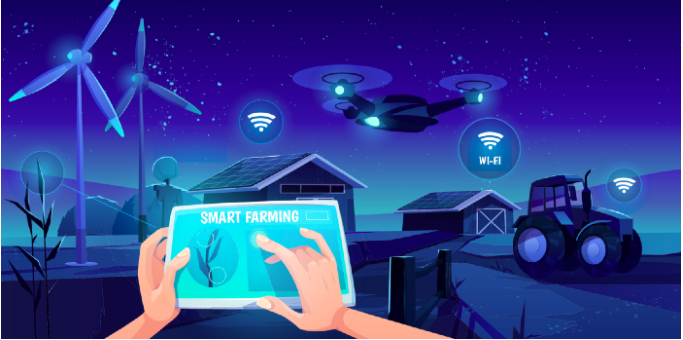I am a CFO and co-founder of a Swiss AgTech company Gamaya. At Gamaya we develop digital agronomy products based on remote sensing technologies (RGB, multispectral and proprietary hyperspectral imagery), agronomy insights and machine learning. We created the company about five years ago at the beginning of 2015, a year after a notable acquisition of Climate Corp by Monsanto for $1bn. I was observing the emergence of the AgTech ecosystem, which includes today hundreds of different startups, and staying very much updated about the leading players and developments in the digital imaging domain.
Back in 2017, I wrote an article about how to ensure that big data brings value to farmers, now three years later I would like to share my observations about the AgTech market and particularly about digital imaging. I want to share what we learned and, perhaps, this information can be useful for companies from remote sensing space with a focus on agriculture. As I am not an expert in the food segment of the AgTech, this part is not included in my analysis.
Main things about agriculture that are crucial to know before working on digital products
As we all learned, agriculture is very much different from other industries, when it comes to the adoption of digital technologies. Its traditional sector, though its changing rapidly. Initially, I didn’t have any experience with agriculture, and learnings mentioned below would help me to understand better how to develop and market digital services in the Ag space.
- Long sales and product development cycles, it requires at least 2–3 growing seasons before getting a marketable product. Farmers are practical and want to test a product in their fields before scaling services. So typically, during a first season, they start testing a product/ service on a small area of land before scaling to the rest of the property.
- Agriculture and agronomy are very local and require a deep understanding of specific crop, market, geography, growing practices. All these variables have to be taken into account during the product development stage and later on for customization.
- Lack of data in the agriculture industry, as its not data-driven industry, when compared for example with the financial sector (banks, insurance, etc.)
- Slow adoption of digital ag services, due to the old generation and traditional nature of the industry. It is changing quickly because of the new generation and the development of new technologies. There is a specific article that I wrote about the adoption of digital technologies in agriculture.
What works and what doesnt? — results of the analysis of the Agtech companies over the last six years
Shubhang Shankar, Managing Director at Syngenta Ventures has recently mentioned in his article: “AgTech has been more than just the God that failed, it is the Rebel that has been tamed. From a Venture Capital perspective, the body of evidence that points in that direction is quite undeniable.”
Indeed, one can claim that so far, most of the promises of AgTech companies didn’t materialize. Why is it so? What should we do differently?
- Basic products are being commoditized (e.g., NDVI), today, digital imaging helps to direct scouting and not to diagnose crop issues. Even Descartes Labs, with its successful corn forecast products, decided to pivot from selling digital products, as its difficult to differentiate when everyone has access to the same data and information to build their own AI models. Therefore the competitive advantage is less sustainable. See the article from Descartes Labs here.
- A lot of claims and statements that are not proven with real data from the fields. The benefits of various digital ag solutions depend on multiple factors, such as weather, farm operations, time to react, growing practices, a level of adoption of precision ag machinery and etc.
- Value capturing is difficult; outcome or benefit-based pricing is not really established in the digital agriculture space. Digital ag products are only one part of the solution, as the remaining part has to do with the execution of the given insights. For example, for weed detection and classification product, a farmer has to have machinery with a variable rate spraying technology to fully realize the benefits of the weeds detection solution.
- Selling standalone digital service is challenging and not sustainable. When the digital ag service is integrated with the conventional products of the industry (crop inputs, ag machinery, etc.), the value extraction and adoption can be much higher. B2B solutions prevail, corporate partners from the Ag industry play a significant role in distributing the digital ag services together with their products. So far, going direct to farmers didn’t provide enough commercial traction to most of the players from the digital domain.
- No data-science and product-driven companies succeeded so far (in broad terms), a combination of hardware and/ or software has provided the most tangible success. Both Granular and Blue River Robotics are mostly built around software/ hardware. Some AI is still present, but its not a driving technology there. Its less and less a technology play.
- Drone-based analytics is much less currently adopted vs. satellite-based analytical products. It is quite challenging to identify a reference company from the drone space that successfully deployed digital services on a large scale and in an economically sustainable way. Let me know if you know! There are some successful drone companies that focus on many industries and for which agriculture is not the critical driving industry.
- A platform/ marketplace approach works only when its backed by a reliable partner from the Ag value chain with an established customer base/ access to the market. So far, with few exceptions, most of the digital imaging companies commercialize products and not a platform.
- Access to the customer base/ market is one of the critical success factors in the agriculture domain. Farm management system (FMS) providers (Granular, Cropio, etc.) were acquired not really because of their unique technology, but mostly because of their customer access. They deserve good credit for making to the exit.
Read the entire article in the following link.
Article written by: Igor Ivanov
Article date: Bassel, Switzerland – August 25, 2020






